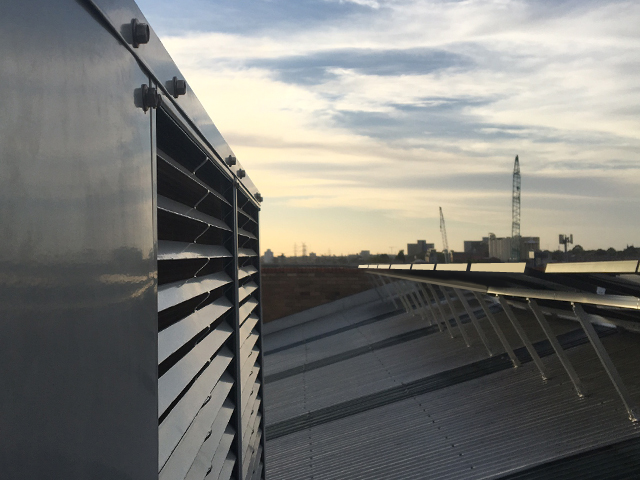Cobalt Powers On
Recently Cobalt completed a major energy efficiency upgrade to our North Melbourne offices.
The works so far include a 12kw, 39 panel array of solar panels, an ultra-efficient HVAC system, extensive sealing and insulation works and new LED lighting throughout the building. These works have already effectively reduced our daily energy consumption by up to 45%. And once stage 2 (energy efficient appliances) is fully complete we are on track to exceed our original target of being 50% self-sufficient in power.
Roadblocks
Since 1996 we’ve believed that design should be socially responsible. So we’ve long wanted our building to have as small an environmental footprint as possible. But at various points we’d been told that our site didn’t suit PV panels due to a taller neighbouring building immediately on our north boundary.
Despite this, Cobalt Director Jack Magree continued to believe a design workaround could be found, if only we could find the right supplier and a means of making it happen.
Solutions Align
In 2018 two key circumstances aligned enabling us to realise our dream; a financial solution which allowed us to fund the investment, and an engineering solution that could work.
In terms of funding we learnt of MCC’s innovative approach to creating smarter more efficient buildings through the Sustainable Australia Fund (SAF). SAF was established by the City of Melbourne Council in 2002 to help businesses to invest in their buildings and operations to achieve better sustainable outcomes. In brief, SAF provides the upfront funding for the works, and the repayments for this loan are based on the resultant savings in energy costs. Once the investment is repaid, the environmental and cost benefits continue indefinitely for a win-win outcome.
The second alignment came via SAF who introduced us to GenesisNow, an energy engineering and implementation services group. GenesisNow immediately felt like kindred spirits to us, as they had a refreshingly can-do culture combined with a highly technical and professional skill set. Genesis’ founder, Geoff Andrews and his Engineering Manager Jon Fettes took the limitations of our site as a challenge that they wanted to solve. Their first step was a full shading analysis and simulation. This proved that shadowing could be managed to negligible levels through a cantilevered installation combined with new technology PV panels each with its own micro inverter.
Comfort and Efficiency
Producing energy is one side of the equation. Using less of it is the other. An initial power and building audit identified our existing HVAC (heating ventilation and air-conditioning unit) and lighting as the biggest and best items to change.
For HVAC GenesisNow again took a less conventional approach. They relied on the experience of HVAC specialists EcoServices who according to Jack “specified a revolutionary German-engineered smart system that moves air silently using the theory of Brownian motion of particles to transfer heat and cold air”. The systems software continuously monitors the outside and inside temperatures, humidity, CO2 levels, and the pressure of the building, to run far more efficiently than conventional systems. As an example, said Jack, “On a recent 42oC (108oF) day our new HVAC system’s compressor was only running at 50% capacity. The system is smart enough to learn how quickly or slowly it achieves the target ‘comfort’ values so it can perform optimally in future.”
A central aspect to this system was to significantly upgrade the seals in the building; no mean feat given the fact that our office was built as a basic warehouse in the 1950’s. Another measure of how well the system performs is that despite the studio’s industrial height ceilings the multiple sensors show minimal temperature stratification, keeping the temperature within 1-2 deg throughout the building.
Capping off the HVAC’s smarts, is complete IoT monitoring and control. This allows offsite, expert system diagnostics and onsite adjustment through a web-based portal. According to Jack, “watching the system’s dashboard certainly helps motivate us to use energy wisely, albeit can be mildly addictive!”

Let There Be Light
The last major piece of the upgrade was to replace our 150W metal halide ‘high bay’ studio lights. Designers are very demanding about their light; needing ample levels of even, natural tone to minimise shadows, render colours accurately and avoid over bright or dull areas.
The studio level’s 20 ‘high bay’ halide lights were originally selected 15 years ago as the premium choice of evenly illuminating the studio by reflecting some of their light off the high pitched ceiling. And the light fittings themselves looked great as well.
In comparison, LED have a comparatively narrow focus so a low-power alternative that equalled the status quo was always going to be difficult. The solution involves a triple LED bulb custom designed to fit into the existing housing to reflect light up and down, as well as additional skylight-style LED panel lights to create close to uniform 270 lux lighting at desk level throughout the studio.
The Result
Apart from lower environmental impact and power bills, the result of our eco upgrade is greater comfort, better lighting with the consensus from our team being overwhelmingly positive.
- “It just feels pleasant, and quiet all the time”
- “Transformative”
- “Not sure how we put up with the old system for so long”
- “Great that we are reducing our CO2 and fossil fuel use”
- “We’ve literally breezed through the hottest summer on record without noticing”









